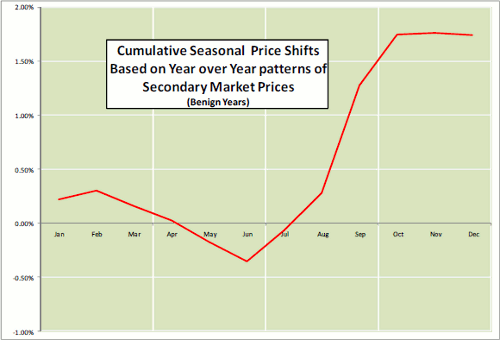One of the issues we discuss regularly on Artemis is the fluctuation in secondary market outstanding catastrophe bond pricing over the course of the year and how seasonal weather patterns, such as the U.S. hurricane season, impact pricing. As with any secondary market, there are effects that change pricing across wide swathes of the marketplace, led by the effects of seasonal weather patterns and storm formation across the globe.
It’s not just U.S. hurricane formation in the Atlantic that affects secondary cat bond pricing. It is the most pronounced seasonal change because so much of the market is exposed to the U.S. hurricane season but other weather patterns also have an impact on pricing, such as the European windstorm season.
There is a very clear pattern throughout the year which see’s secondary market cat bond prices start off the year with some upwards pressure from the European windstorm season peak. Then as the European windstorm season comes to a close, there can be some pressure on U.S. severe thunderstorm exposed bonds, but this is generally tempered by the approaching hurricane season which typically see’s a decline in pricing across many marks as the season begins. Then, once we’re a month into the hurricane season this is when we begin to see strong price rises across many U.S. hurricane exposed marks. This increase in pricing continues through to October at which time the upwards pressure from the U.S. hurricane season diminishes and we’re back into some lighter price increases on European windstorm bonds as that season begins once again.
At the moment the most noticeable impacts on pricing are from U.S. hurricanes and European windstorms, as those are the two most dominant seasonal perils in the outstanding cat bond market. Other perils which have some seasonal impact on pricing include Japan typhoon and U.S. tornado exposed cat bonds, but currently with only a few bonds exposed to those perils the impact is not noticeable across the whole of the secondary cat bond market. U.S. hurricane drives seasonality unsurprisingly, with as much as 70% of the cat bond markets exposure focused on that risk.
In their recent report on the third quarter cat bond market, Lane Financial LLC, a consulting firm and broker-dealer focused on the insurance-linked security sector, included a really interesting chart which shows the seasonality of cat bond pricing very clearly. The chart shows the cumulative seasonal price shifts across the year using data from benign years when losses have been average.

Cumulative Seasonal Price Shifts Based on Year over Year patterns of Secondary Catastrophe Bond Market Prices
So there is a very definite pattern which fits with the start and finish of the U.S. hurricane season and it’s also possible to fit the other perils to this shape as well. Of course, a year which is not so benign may feature unusual price spikes at any time of the year according to when a major loss event had occurred.
The shape of seasonal cat bond pricing also clearly shows the upwards pricing movement which has helped ILS fund managers to achieve such good returns in recent months. In a benign year ILS funds will make their best returns in the months which have the highest upwards pricing pressure, this year has been a great example of this as we wrote here last week.
You can download a full copy of the quarterly ILS market report on the Lane Financial website where you’ll need to register to download a copy.
 View all of our Artemis Live video interviews and subscribe to our podcast.
View all of our Artemis Live video interviews and subscribe to our podcast.
All of our Artemis Live insurance-linked securities (ILS), catastrophe bonds and reinsurance video content and video interviews can be accessed online.
Our Artemis Live podcast can be subscribed to using the typical podcast services providers, including Apple, Google, Spotify and more.































